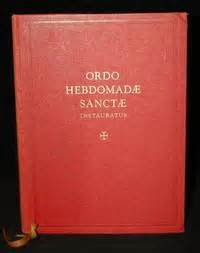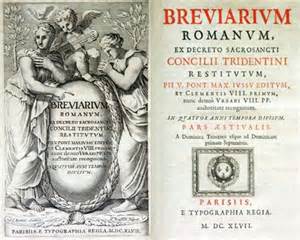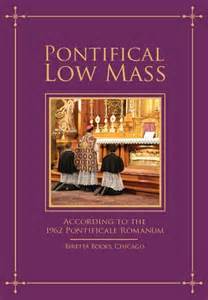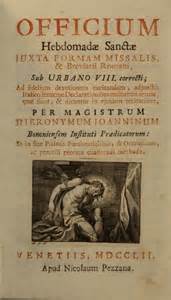
What are liturgical books? They are texts approved by the Holy See, containing the orderly arrangement of the prayers, hymns, readings, and directives to be followed by the priests in the Church’s liturgy. How many books are there? There are three types of liturgical books. First, there are the books used for the observance of Mass and the seasonal rites. Second, the books used for the Divine Office. Third, for the administration of the Sacraments and Sacramentals. Lastly, the books containing the official musical texts of the Mass,
Divine Office and other ceremonies.
![missale-romanum-altar-missal-photo-1[1]](http://www.magnificatmedia.com/wp-content/uploads/2015/11/missale-romanum-altar-missal-photo-11.jpg) Lets start with the large book seen on the altar at every Mass, the Roman Missal. This book is popularly called the “altar missal” and it contains the texts, calendar, and rubrics needed by the celebrant to offer the Holy Sacrifice of the Mass. The typical edition of the Roman Missal is often referred to as the “1962 edition”. There is also a derivative of the full Roman Missal, the Missale Defunctorum or the Missal of the Deceased. This thin book — usually bound in black — is a compilation of all the Requiem Masses and funerary rites printed in the standard missal, though its latest edition was published in 1957.
Lets start with the large book seen on the altar at every Mass, the Roman Missal. This book is popularly called the “altar missal” and it contains the texts, calendar, and rubrics needed by the celebrant to offer the Holy Sacrifice of the Mass. The typical edition of the Roman Missal is often referred to as the “1962 edition”. There is also a derivative of the full Roman Missal, the Missale Defunctorum or the Missal of the Deceased. This thin book — usually bound in black — is a compilation of all the Requiem Masses and funerary rites printed in the standard missal, though its latest edition was published in 1957.
Let’s turn our attention now to the books used for the Holy Week ceremonies. The contents of these books are actually printed in the altar missal. However, as the altar missal is so large, it is usually preferred to use these books specifically compiled for Holy Week. The first and primary book used for Holy Week is the Ordo Hebdomadæ Sanctæ
Week. The first and primary book used for Holy Week is the Ordo Hebdomadæ Sanctæ
Instauratus or in English: The Restored Order of Holy Week. The OHS, as it is popularly known, and thereby the reformed order of the Holy Week services was the result of Pope Pius XII’s Liturgical Commission, which had the primary task to restore the Holy Week rites back to their ancient times of observance. The first edition of the OHS was published in 1955, though not actually printed until 1956. The OHS also underwent some further minor revisions in 1957 and again in 1962. But as these later editions are difficult to find, usually a 1956 edition is used, and often with the later changes penciled in. There is also a pontifical form of the OHS that would be used by a bishop, called the Ritus Pontificalis Ordinis Hebdomadæ Sanctæ Instaurati. Or as said in English: The Rite of Bishops for the Restored Order of Holy Week.
Next we come to the Clementine Instruction concerning the observance of
the Forty Hours Prayer. The Clementine Instruction is actually a rubrical document whose primary author was St. Charles Borromeo. The Forty Hours Prayer is a special devotion to the Blessed Sacrament when it is continuously exposed for 40 consecutive hours and includes special votive Masses to be observed.
 Now we come to the books used for the Divine Office. The primary book used by the clergy is the Breviarium Romanum or the Roman Breviary, which was published in 1961. The book is so-called a “breviary” because of it’s abbreviated form that was originally developed for the traveling clergy, and popularized by the mendicant Franciscan Friars.
Now we come to the books used for the Divine Office. The primary book used by the clergy is the Breviarium Romanum or the Roman Breviary, which was published in 1961. The book is so-called a “breviary” because of it’s abbreviated form that was originally developed for the traveling clergy, and popularized by the mendicant Franciscan Friars.
Now we come to the books used for the administration of the Sacraments and
Sacramentals. The most important of these is the Rituale Romanum or Roman Ritual. This book contains the official and sacramental rites and blessings as universally observed in the Roman Rite, thus this book does not contain local customs. The version of the ritual containing local customs is called a Collectio Rituum or Collection of Rites. Next we come to the ritual for bishops called the Pontificale Romanum or Roman Pontifical. This book is often published as a set of three separate volumes, the first of which dates from 1888, while the second and third parts were slightly revised and republished in 1962. The Pontifical includes such ceremonies as the consecration of an altar, the dedication of a church, ordinations to holy orders, the rite of confirmation and solemn excommunication, and even the proceedings of a synod.
Finally, we come to the books containing the official musical text used in the celebration of Mass and other ceremonies. Firstly, there is the Kyriale. This book contains the various  modes of the sung parts of the Ordinary such as the Kyrie, Gloria, Credo, Sanctus, Agnus Dei, as well as those part dialogued with the sacred ministers, such as the Dominus vobiscum and Ite, missa est. Next is the Graduale Romanum or Roman Gradual. This book contains all of the chant propers for the Mass, not only its namesake Graduals, but also the antiphons for the Introit, Offertory and Communion, as well as the Tracts, Alleluias and Sequences. Another of the official chant books is actually an instructional manual on how to sing Gregorian chant which also contains some of the most basic Gregorian chants. This book is called the Cantorinus and it was produced in 1911. Finally, there is the Officium Hebdomadæ Sanctæ or the Office of Holy Week. Published in 1959, this book contains the chants used during the Holy Week ceremonies. The full Latin title of this book is: Cantus Passionis Domini Nostri Jesu Christi Secundum Mattheum, Marcum, Lucam et Joannem or The Chant of the Passion according to Matthew, Mark, Luke and John.
modes of the sung parts of the Ordinary such as the Kyrie, Gloria, Credo, Sanctus, Agnus Dei, as well as those part dialogued with the sacred ministers, such as the Dominus vobiscum and Ite, missa est. Next is the Graduale Romanum or Roman Gradual. This book contains all of the chant propers for the Mass, not only its namesake Graduals, but also the antiphons for the Introit, Offertory and Communion, as well as the Tracts, Alleluias and Sequences. Another of the official chant books is actually an instructional manual on how to sing Gregorian chant which also contains some of the most basic Gregorian chants. This book is called the Cantorinus and it was produced in 1911. Finally, there is the Officium Hebdomadæ Sanctæ or the Office of Holy Week. Published in 1959, this book contains the chants used during the Holy Week ceremonies. The full Latin title of this book is: Cantus Passionis Domini Nostri Jesu Christi Secundum Mattheum, Marcum, Lucam et Joannem or The Chant of the Passion according to Matthew, Mark, Luke and John.
To here more about the Liturgical Books of the Roman Rite, listen to Learning about the Roman Liturgy with Louis Tofari on Magnificat Radio at www.magnificatmedia.com at 10am, 1pm, 6:30pm, and 10pm, CST, USA ~ “Living Our Faith”© . To purchase books and materials mentioned on Learning about the Roman Liturgy with Louis Tofari visit this link: Romanitas Press
Here is some beautiful music
